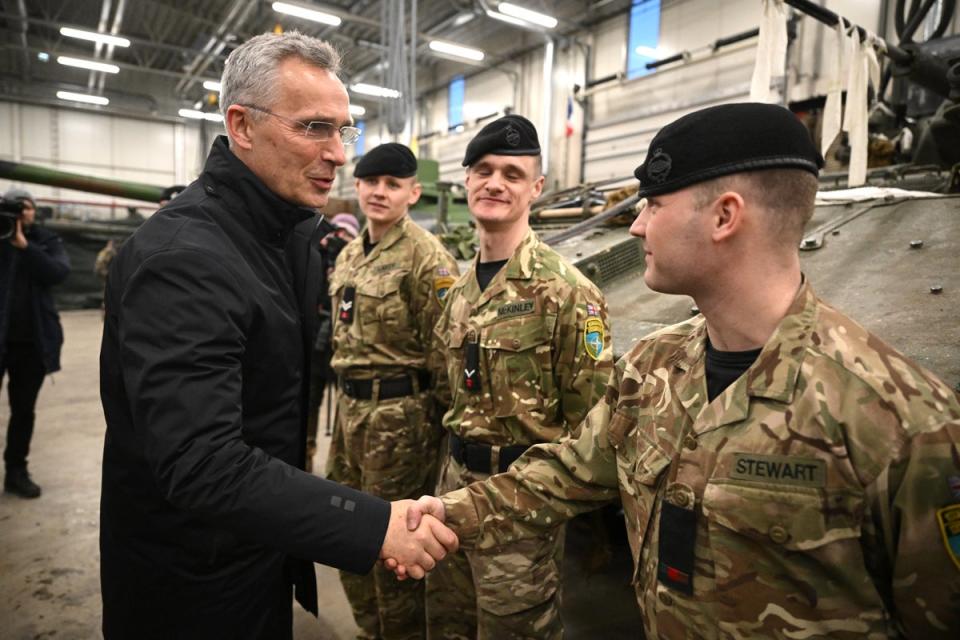NATO to massively boost high readiness forces to over 300,000 after Vladimir Putin’s invasion of Ukraine

Nato will massively increase the number of its forces at high readiness to more than 300,000 following Vladimir Putin’s invasion of Ukraine, Secretary-General Jens Stoltenberg said on Monday.
He announced the dramatic scaling up of the response force as the West reshapes its security strategy following the Russian president’s military aggression.
“We will transform the Nato response force and increase the number of our high readiness forces to well over 300,000,” Mr Stoltenberg told reporters ahead of a Nato summit in Madrid later this week.
Nato’s quick reaction force, the Nato response force, so far has some 40,000 troops.
At the Madrid summit, Nato will also change its language on Russia that in the alliance’s last strategy from 2010 was still described as a strategic partner.
“That will not be the case in the strategic concept that we will agree in Madrid,” Mr Stoltenberg said.
“I expect that allies will state clearly that Russia poses a direct threat to our security, to our values, to the rules-based international order.”
The Nato move shows how Mr Putin’s invasion of Ukraine has backfired, according to military experts, as it has united rather than weakened the West.
The invasion has also led to Finland and Sweden submitting applications to join the western military alliance which has also strengthened its eastern flank with more troops, aircraft and other equipment being deployed.
Meanwhile, Nato’s first new strategy concept in a decade will cite China as a concern for the first time, say the alliance’s diplomats.
But member states remain at odds over how to describe the country with the world’s largest military and its relationship with Russia, they added.
Both a summit of the G7 rich industrial democracies now underway in Germany and a Nato summit to follow will tackle China’s deepening ties with Russia after Moscow’s invasion of Ukraine, and what is seen as the growing inclination of China to flex its geopolitical muscle and coercive economic might abroad.
The new strategic concept to be endorsed at the Nato summit in Madrid on Wednesday and Thursday will address increasing threats posed by Russia and, for the first time, China, the world’s second largest economy, US officials said last week.
A White House official voiced confidence on Sunday that the document would include “strong” language on China, but said the negotiations were continuing ahead of the Nato summit in Madrid on June 29-30.
Nato diplomats said the United States and Britain have pushed for more forceful language to reflect what they see as China’s increasing military ambitions and growing concern that it could attack the democratically governed island of Taiwan, which Beijing regards as its own territory.
France and Germany, given major European industrial investment in China, meanwhile favour more measured references, said the Nato diplomats, who spoke on condition of anonymity since the document was still being finalised.
One diplomat said a compromise was taking shape under which China would be described as a “systemic challenge”, while including balancing language referring to a “willingness to work on areas of common interest” with Beijing.
The strategy document, which will update US-led Nato’s objectives and values, will also state member states’ “awareness of the need for “resilience”, the diplomat said.
Negotiators are in addition fine-tuning how to describe the relationship between China and Russia, with the Czech Republic and Hungary strongly opposed to the phrase “strategic convergence” to define it, one of the diplomats said.
Nato officials are racing to complete the strategic concept in time for the Madrid summit, where the Russian invasion of Ukraine will take centre stage.
Britain recently adopted language describing Russia as an “acute, direct threat” and China as a “strategic challenge”.
The Pentagon’s latest annual report to the US Congress underscored the importance of “meeting the pacing challenge presented by the People’s Republic of China’s increasingly capable military and its global ambitions”.
US officials stressed the importance of including China in Nato’s updated strategic concept, and Australia, New Zealand, Japan and South Korea were therefore invited to the Nato summit for the first time.
The point was to signal that Nato is not “taking our eye off the ball in China” even as it focuses on strengthening Ukraine’s defences, one of the officials said. “It’s firmed up the democratic world on both Russia and China.”
“Nato can’t afford to ignore China,” agreed a European official. “Europe was a bit behind in recognising this, but views have definitely shifted in light of Hong Kong,” referring to Beijing’s security crackdown on the Asian financial hub.
A third official said: “We tried to build an era of being nice and incentivising China and we got President Xi (Jinping),” the Chinese leader who critics say has taken China on a more authoritarian path at home and aggressive course abroad. “So I think most people would think a different approach is needed.”

